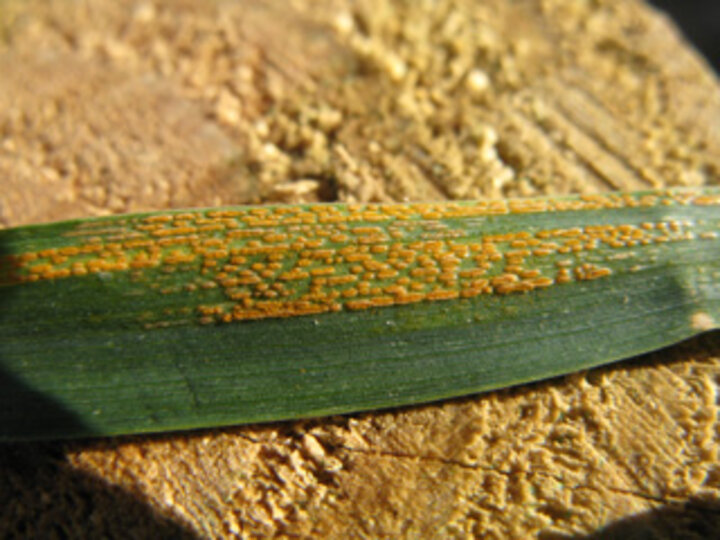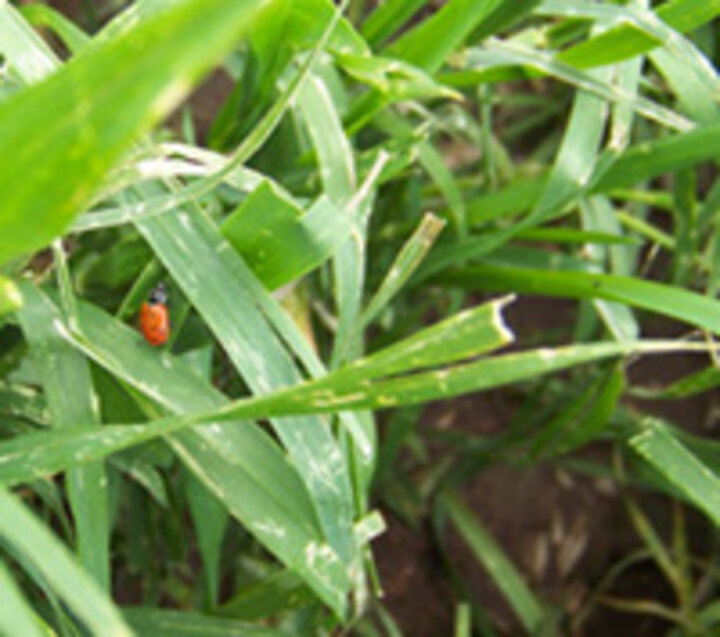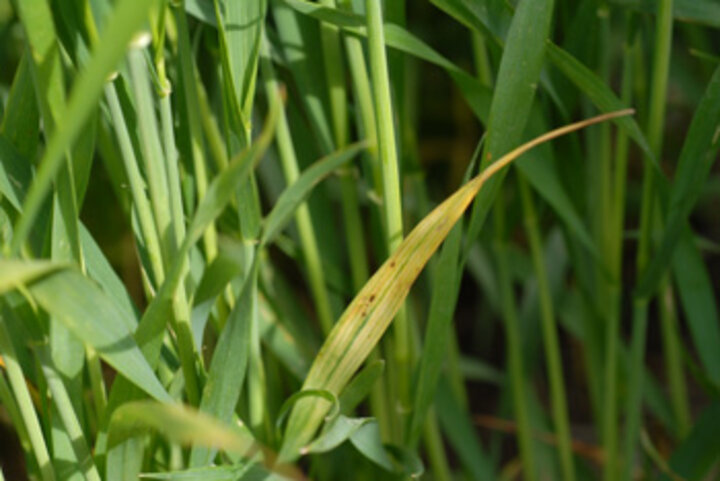
|

|
| Figure 1. Stripe rust observed in Jefferson County on May 3. (Photo credit: Bob Kacvinsky) | Figure 2. Septoria tritici blotch on a wheat sample received by the UNL Plant and Pest Diagnostic Clinic on May 11. |
|
May 13, 2010
Diseases
Weather conditions (wet and cool to moderate temperatures) over the last two weeks have favored development of foliar diseases on wheat. Stripe rust (Figure 1) was found in Jefferson County on May 3. Septoria tritici blotch (Figure 2) and tan spot are the most common foliar diseases that have been seen in wheat fields over the last two weeks. Severity of these two diseases is higher in fields in which wheat was drilled into wheat stubble. In some fields, Septoria tritici blotch can be seen on flag leaves.
Powdery mildew also is showing up on lower leaves in many wheat fields. Given the wet weather that has prevailed so far, producers are advised to continue scouting their fields and be prepared to apply a fungicide to protect the flag leaf from foliar diseases.
Insect Pests
Bird cherry oat aphids (Figure 3) were observed in several wheat fields this week in Clay, Nuckolls, and Thayer counties. There have been several reports of aphids at low levels in wheat fields over the last two weeks. Aphids transmit barley yellow dwarf virus (BYDV), but so far only a very low incidence of this virus (Figures 4 and 5) has been observed on wheat. Even if aphid populations aren’t transmitting the virus, they can cause economic damage to wheat. Scout for aphids to determine if treatment is warranted.
Aphid Scouting Tips
Randomly select wheat stems to examine for aphids. A minimum of 30 stems per field should be examined to get a good estimate of aphid numbers. Often aphids are distributed in pockets within the field with large areas of the field uninfested. Do not make treatment decisions based only on sampling in the hot spots.
Table 1 shows treatment thresholds for aphids commonly found in eastern Nebraska. These vary by aphid and plant growth stage. Information to identify Nebraska aphids in wheat is available in NebGuide G1284, Cereal Aphids. Insecticide use information for aphid control in wheat can be found at http://entomology.unl.edu/instabls/waphids.shtml

Figure 6. Hail damaged wheat on the Nuckolls/Thayer county line May 11. |
Environmental Factors
Symptoms caused by environmental factors also are showing up. Some wheat fields in south central Nebraska close to the border with Kansas recently sustained hail damage (Figure 6). Yellow field areas due to nutrient deficiency/tie-up are still visible in some areas. They range from small patches to large areas.
Stephen Wegulo, Extension Plant Pathologist, Lincoln
Robert Wright, Extension Entomologist, Lincoln
Jennifer Rees, Extension Educator, Clay County
|
Table 1. Number of small grain aphids per stem of wheat which would justify chemical control. |
|||||
| Type of Aphid | Seedling | Boot to Heading | Flowering | Milky Ripe | Milk - Medium Dough |
| Greenbug | 5-15 | 25 | >25 | >25 | >25 |
| Corn leaf aphid | 20 | 30 | >25 | >25 | >25 |
| Birdcherry-oat aphid | 20 | 30 | 5 | 10 | >10 |
| English grain aphid | 30 | 50 | 5 | 10 | >10 |



